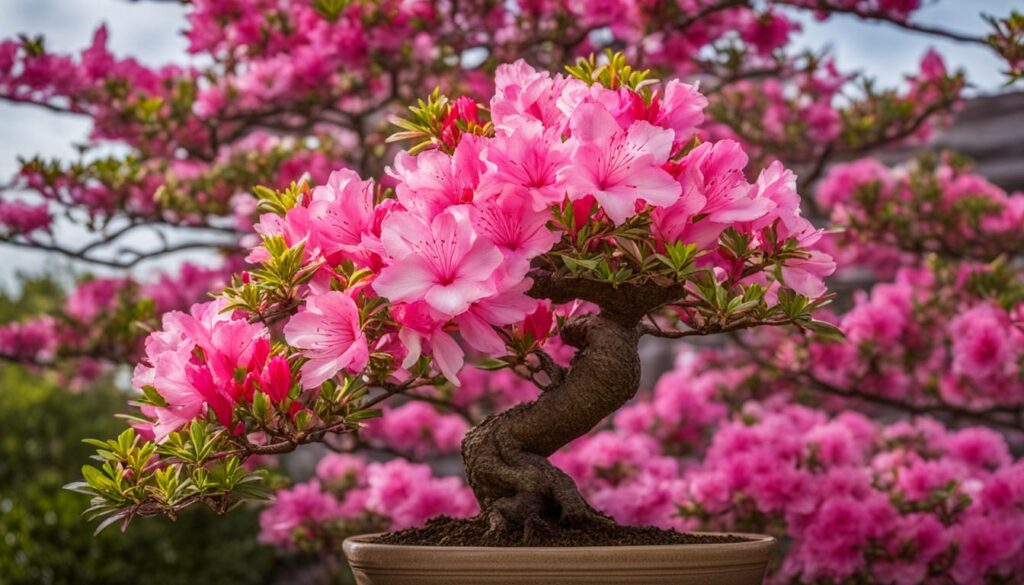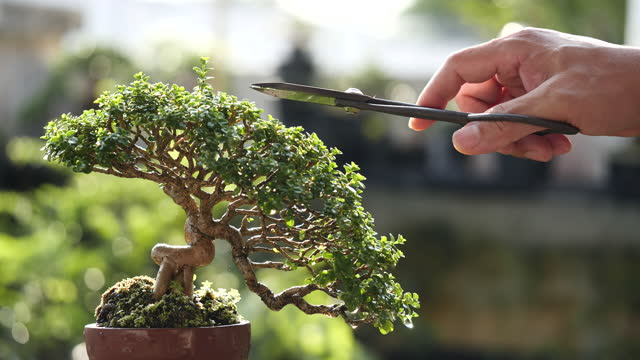Azalea Bonsai is a captivating and delicate variety of bonsai that requires specific attention and care. From selecting the right variety for your collection to understanding the proper pruning techniques, we will cover everything you need to know.
Discover the fascinating history and artistry behind Azalea Bonsai, and explore its rich cultural significance. We will introduce you to the different varieties available, such as the vibrant Satsuki Azalea and the resilient Kurume Azalea.
Learn essential tools and techniques for potting your Azalea Bonsai, including the ideal soil composition and potting essentials. Understand the proper watering methods to ensure the health and vitality of your bonsai tree.
Discover the importance of fertilizing and maintaining the perfect environment for your Bonsai. We will also delve into pruning techniques, pest and disease prevention, and tips for displaying your plant in exhibitions.
Throughout this guide, we will provide you with step-by-step instructions and valuable tips to help you create and maintain a thriving collection. So let’s dive in and embark on a rewarding journey with these stunning bonsai trees.
Understanding the Azalea Bonsai: An Introduction
Azalea Bonsai, known for its exquisite flowers, delicate foliage, and compact size, has captured the hearts of bonsai enthusiasts worldwide. These miniature trees embody the essence of beauty and grace, offering a stunning representation of nature’s artistry in a manageable form.
Unlike other types of bonsai trees, Azalea trees have distinct characteristics that make them stand out. Their vibrant and abundant blooms, ranging from hues of pink, red, white, and purple, create a spectacle of color that captivates the eye.
The history and cultural significance of Azalea Bonsai add a layer of fascination to these enchanting plants. Originating from Asia, particularly Japan, it has been cultivated for centuries, symbolizing harmony, balance, and tranquility. They are often associated with the celebration of spring and are prominently featured in traditional bonsai exhibitions.
Caring for Azalea Bonsai requires attention to detail and a thorough understanding of their specific needs. In the following sections, we will guide you through the essentials of Azalea Bonsai care, including watering, pruning, and providing the ideal environment for these delicate beauties to thrive.
The History and Artistry Behind Azalea Bonsai
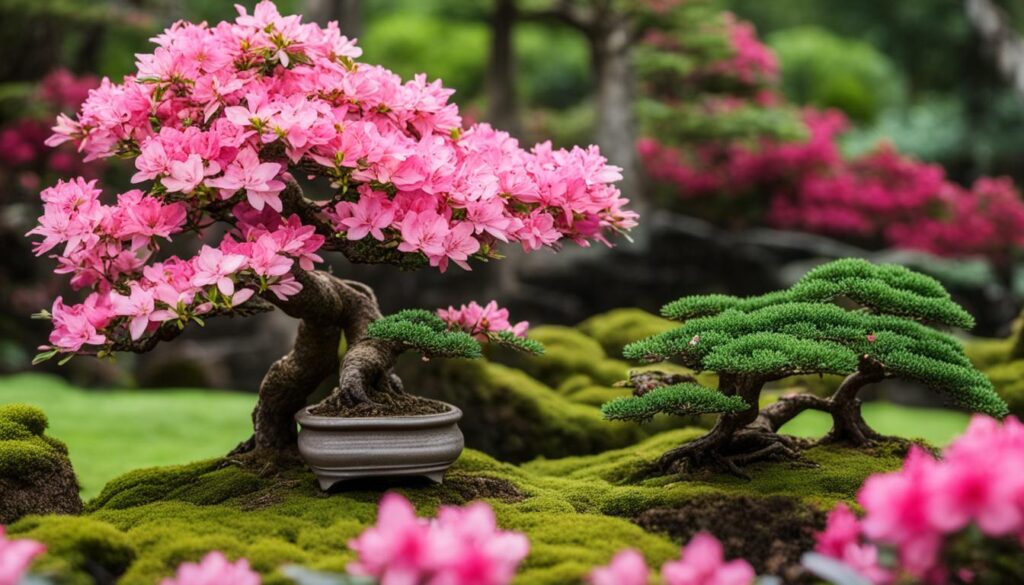
In this section, we will delve into the rich history of Azalea Bonsai and explore the artistry behind creating these beautiful trees. Throughout the centuries, it has been cultivated and admired for its exquisite beauty and cultural significance.
Azalea Bonsai has a fascinating history that dates back to ancient China and Japan. They were originally cultivated from wild azaleas, and through generations of selective breeding and cultivation techniques, they have evolved into the stunning bonsai trees we see today.
The artistry behind Azalea Bonsai lies in the meticulous process of shaping and styling these miniature trees. Skilled bonsai artists carefully shape the branches and leaves, delicately sculpting them to create harmonious compositions that resemble the natural growth patterns of full-sized azalea trees.
Creating an Azalea Bonsai masterpiece is truly an art form that requires patience, skill, and a deep understanding of horticulture. The process involves meticulously pruning, wiring, and training the branches to achieve the desired shape and aesthetic appeal.
Azalea Bonsai artistry also extends to the careful selection of pots and display stands. These elements are chosen to complement the tree’s characteristics and enhance its overall visual impact. The proper choice of pots and display stands takes into account factors such as color, size, and material, ensuring that they harmonize with the tree’s beauty.
The artistry behind Azalea Bonsai goes beyond the physical beauty of the trees. These miniature masterpieces evoke a sense of tranquility, balance, and harmony, reflecting the Zen philosophy that is deeply ingrained in bonsai culture. Azalea Bonsai represents a connection between nature and humans, reminding us of the beauty and fragility of life.
By appreciating the history and artistry behind Azalea Bonsai, you gain a deeper understanding and admiration for these remarkable trees. In the next section, we will explore various varieties of Azalea Bonsai, allowing you to discover the unique characteristics and charm of each.
Choosing Your Azalea Bonsai: Varieties Explained
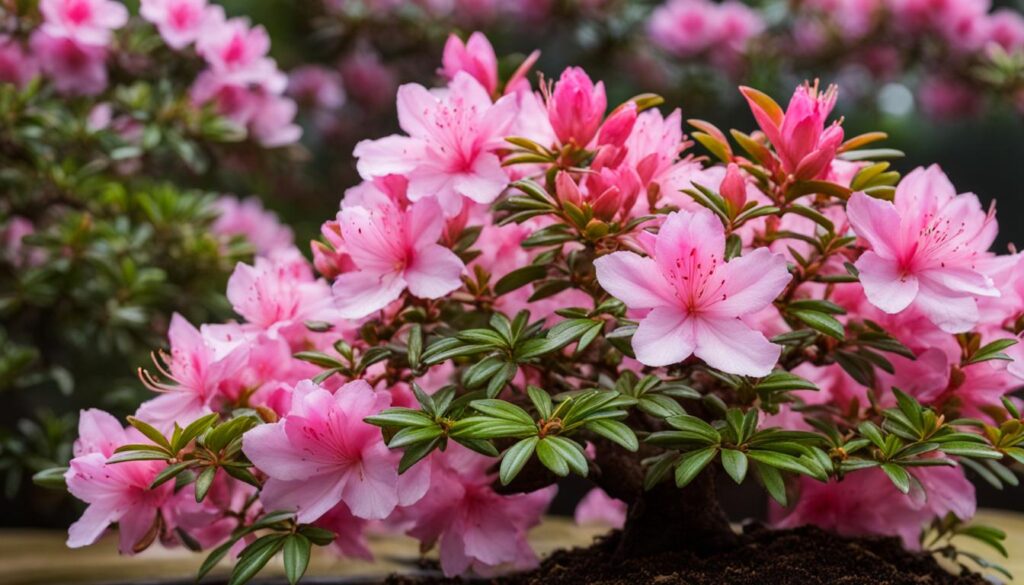
In this section, we will explore different varieties of Azalea Bonsai and help you choose the right one for your collection. Azalea Bonsai trees come in a wide range of colors and sizes, each with its own unique characteristics and appeal. Whether you prefer vibrant and diverse flowers or compact and resilient trees, there is an Azalea Bonsai variety that will suit your preferences and style.
Satsuki Azalea: The Colorful Canvas
The Satsuki Azalea is renowned for its spectacular flower display. This variety offers a stunning range of colors and patterns, making it a favorite among bonsai enthusiasts. From vibrant pinks and reds to delicate whites and purples, the flowers of the Satsuki Azalea create a mesmerizing canvas of color. With proper care and maintenance, this variety can reward you with a breathtaking floral showcase.
Kurume Azalea: Compact and Resilient

The Kurume Azalea is known for its compact size and resilience, making it an excellent choice for beginners and those with limited space. This variety produces an abundance of small, bell-shaped flowers that adorn the tree in a vibrant display. The Kurume Azalea is highly adaptable and can tolerate a variety of growing conditions, making it a versatile addition to any bonsai collection.
Other Compelling Varieties for Your Collection
If you’re looking to diversify your Azalea Bonsai collection further, there are several other compelling varieties to consider. Some popular options include:
- Indica Azalea: Known for its large and showy flowers, the Indica Azalea adds a bold and dramatic touch to any bonsai collection.
- Kaempferi Azalea: This variety features striking flowers with intricate patterns and vibrant colors, making it a true showstopper.
- Kiusianum Azalea: With its delicate pink flowers and compact growth habit, the Kiusianum Azalea adds an elegant charm to bonsai displays.
These are just a few examples of the many Azalea Bonsai varieties available. Each variety has its own unique beauty and characteristics, allowing you to create a diverse and captivating bonsai collection.
| Variety | Description |
|---|---|
| Satsuki Azalea | Offers a range of vibrant flower colors and patterns. |
| Kurume Azalea | Compact size and resilient nature, suitable for beginners. |
| Indica Azalea | Large and showy flowers, add drama to bonsai displays. |
| Kaempferi Azalea | Striking flowers with intricate patterns. |
| Kiusianum Azalea | Delicate pink flowers and elegant charm. |
Essential Tools for Azalea Bonsai Care
To properly care for your Azalea Bonsai, you will need specific tools. In this section, we will outline the essential tools required for Azalea Bonsai care. By having the right tools on hand, you will be able to maintain the health and aesthetics of your Azalea Bonsai.
1. Pruning Shears: Pruning shears are essential for trimming and shaping your Azalea Bonsai. They allow you to remove dead or overgrown branches and maintain the desired size and form of your tree. When using pruning shears, make clean cuts at a 45-degree angle to promote quick healing.
2. Concave Cutters: Concave cutters are specialized bonsai tools that are designed to make precise cuts when removing larger branches. They create a concave shape on the cut surface, which helps the wound heal quickly and smoothly. Use concave cutters for larger branches that require a deeper and cleaner cut.
3. Wire Cutters: Wire cutters are used for removing or adjusting bonsai wire during the shaping process. When wiring your Azalea Bonsai, it’s important to use the right gauge of wire and make sure it is applied in a way that allows for the tree’s growth while maintaining the desired shape. Wire cutters help you remove the wire without damaging the branches.
4. Root Pruning Tools: Root pruning is necessary to maintain the health of your Azalea Bonsai’s root system. Root pruning tools include root shears and root hooks, which are used to carefully trim and shape the roots during repotting. Root pruning promotes better root development and prevents the tree from becoming root-bound.
5. Watering Can: Proper watering is essential for the health of your Azalea Bonsai. A watering can with a narrow spout allows for precise watering, ensuring the soil is evenly moist but not waterlogged. Avoid using a strong stream of water that can dislodge the soil or damage the tree’s delicate branches.
6. Tweezers: Tweezers are useful for removing small debris, insects, or dead leaves from your Azalea Bonsai. They allow you to carefully clean and maintain the aesthetics of your tree without causing any damage.
7. Bonsai Soil Scoop: A bonsai soil scoop or spoon helps you accurately measure and distribute the soil during repotting. It allows for precise placement of soil around the roots, ensuring proper drainage and airflow.
8. Bonsai Brush: A soft bonsai brush is used to gently remove dust and debris from the leaves and branches of your Azalea Bonsai. Regular brushing helps keep the tree clean and promotes healthy growth.
9. Turntable: A bonsai turntable is a rotating platform that makes it easier to work on your Azalea Bonsai from all angles. It allows you to view and access different parts of the tree without constantly repositioning it.
By having these essential tools for Azalea Bonsai care, you will be well-equipped to maintain the health, beauty, and longevity of your bonsai tree.
Azalea Bonsai Soil Composition and Potting Essentials

The soil composition and potting technique are crucial elements in ensuring the health and growth of your Azalea Bonsai. The right soil composition provides the necessary nutrients and moisture required for your bonsai to thrive. Additionally, proper potting techniques ensure your Azalea Bonsai has sufficient space to grow and develop its root system.
Soil Composition:
When it comes to soil composition for Azalea Bonsai, two essential factors to consider are acidity and drainage. Azaleas prefer acidic soil conditions, with a pH level between 4.5 and 6.0. This acidic environment enables optimal nutrient absorption and promotes healthy growth. To achieve the ideal acidity level, you can use a specialized azalea bonsai soil mix or create your own by combining various organic materials such as peat moss, pine bark, and sphagnum moss.
Potting Essentials:
The potting process is a critical step in the care of your Azalea Bonsai. Here are some key points to remember when potting your Azalea Bonsai:
- Choose a suitable bonsai pot: Select a pot that complements the size and style of your Azalea Bonsai. It should provide adequate space for root growth and have drainage holes at the bottom to prevent waterlogging.
- Prepare the bonsai soil: Ensure that you have the appropriate soil mixture ready before potting your Azalea Bonsai. This mixture should meet the acidity requirements and have good drainage properties. You can include a layer of coarse substrate at the bottom of the pot to enhance drainage.
- Carefully remove the bonsai from its current pot: Gently loosen the soil around the root system and carefully remove the bonsai from its current pot. Be cautious not to damage the roots during this process.
- Trim excess roots and prune branches if needed: Inspect the root system and trim any excessively long or damaged roots. Additionally, prune any branches that may hinder the proper placement of the bonsai in the new pot.
- Repot the Azalea Bonsai: Place the Azalea Bonsai in the new pot, ensuring that it is centered and positioned at the desired angle. Fill the pot with the prepared bonsai soil mixture, making sure to distribute it evenly around the roots.
- Water the bonsai: After repotting, give your Azalea Bonsai a thorough watering to settle the soil and remove any air pockets. Provide adequate moisture without overwatering.
By following proper potting techniques and using the right soil composition, you can provide a healthy environment for your Azalea Bonsai to grow and flourish.
Steps to Potting Your Azalea Bonsai
Proper potting is crucial for the health and development of your Azalea Bonsai. Follow these step-by-step instructions to ensure the successful potting of your Azalea Bonsai tree.
- Select the right pot: Choose a pot that is slightly larger than the current pot but not too big. The new pot should have drainage holes to prevent waterlogging.
- Prepare the soil: Create a suitable soil mixture by combining well-draining bonsai soil with organic matter such as peat moss or pine bark. This will provide the necessary nutrients and moisture retention.
- Remove the tree from its current pot: Gently tap the sides of the pot to loosen the soil and carefully lift the tree out, supporting the root ball with your hand. Take care not to damage the roots.
- Inspect and trim the roots: Examine the roots for any damaged or tangled portions. Trim them with clean bonsai shears, removing any dead or unhealthy roots.
- Position the tree in the new pot: Place the tree in the center of the new pot, ensuring it is upright and positioned at the desired angle.
- Add the soil mixture: Gradually fill the pot with the prepared soil mixture, carefully working it around the roots and ensuring there are no air pockets. Gently tap the pot to help settle the soil.
- Water thoroughly: After potting, water the bonsai thoroughly until water drains out from the bottom of the pot. This will help settle the soil and hydrate the roots.
- Place in a suitable location: Find a location for your newly potted Azalea Bonsai where it can receive the right amount of sunlight and protection from extreme weather conditions.
By following these steps, you can ensure that your Azalea Bonsai is properly potted, providing it with the ideal environment for healthy growth and development.
Watering Your Azalea Bonsai: Techniques and Tips
Proper watering is essential for the health and vitality of your Azalea Bonsai tree. Understanding the correct techniques and tips for watering will ensure that your bonsai thrives and flourishes. In this section, we will provide you with valuable insights on how to water your Azalea Bonsai effectively.
Frequency: Azalea Bonsai trees require regular watering, typically every 2-3 days, depending on factors such as the climate, pot size, and soil condition. Monitor the moisture level of the soil to determine the ideal frequency for watering.
Amount: When watering your Azalea Bonsai, ensure that the entire root system receives moisture. Water the soil evenly until you see it draining from the drainage holes at the bottom of the pot.
Watering Methods: There are two popular methods for watering Azalea Bonsai: soaking and misting. For soaking, immerse the entire pot in a basin or sink filled with water for a few minutes. This allows the soil to absorb water from the drainage holes. Alternatively, misting involves spraying a fine mist of water onto the foliage and soil surface. This method is useful for supplementing watering between soakings.
Water Quality: The quality of water used for your Azalea Bonsai is crucial. Ideally, use rainwater, distilled water, or tap water that has been left standing for 24 hours to allow chlorine to evaporate. Avoid using hard water or water with high mineral content, as it can affect the acidity of the soil and potentially harm your bonsai.
Common Mistakes to Avoid:
- Overwatering: Excess water can lead to root rot or other root-related issues. Ensure that the soil is well-drained and never let your bonsai sit in standing water.
- Underwatering: Insufficient water can cause your Azalea Bonsai to become dehydrated. Regularly check the soil moisture and adjust your watering schedule accordingly.
- Watering from the top: Avoid watering the foliage directly, as it can lead to waterlogged leaves and encourage fungal growth. Focus on watering the soil and roots instead.
By following these techniques and tips, you can provide the optimal watering conditions for your Azalea Bonsai, promoting healthy growth and vibrant blooms.
Nutrition: Fertilizing Your Azalea Bonsai Tree
Fertilizing is an essential aspect of Azalea Bonsai care as it provides the necessary nutrients for healthy growth and vibrant blooms. Proper fertilization ensures that your Azalea Bonsai receives all the essential elements it needs to thrive and flourish.
When it comes to fertilizing your Azalea Bonsai, it’s important to choose the right type of fertilizer and apply it at the appropriate times to maximize its benefits. Organic fertilizers, such as fish emulsion or compost, are often recommended for it, as they provide a slow release of nutrients and promote overall soil health.
When applying fertilizer, it’s essential to follow the instructions on the product label and avoid overfertilization, as it can burn the roots and cause damage to the tree. Generally, it is best to fertilize your Azalea Bonsai during the growing season, from spring to fall, reducing or stopping fertilization during the winter months.
Remember to water your Azalea Bonsai thoroughly before applying fertilizer to avoid burning the roots. This helps to ensure that the fertilizer is properly distributed throughout the root system.
To apply the fertilizer, you can use either a liquid or granular form. Liquid fertilizers are often diluted in water and applied during regular watering sessions, providing a gradual release of nutrients. Granular fertilizers can be applied directly to the soil, usually in small amounts, and then watered in to allow for absorption.
Maintaining the Perfect Environment for Azalea Bonsai
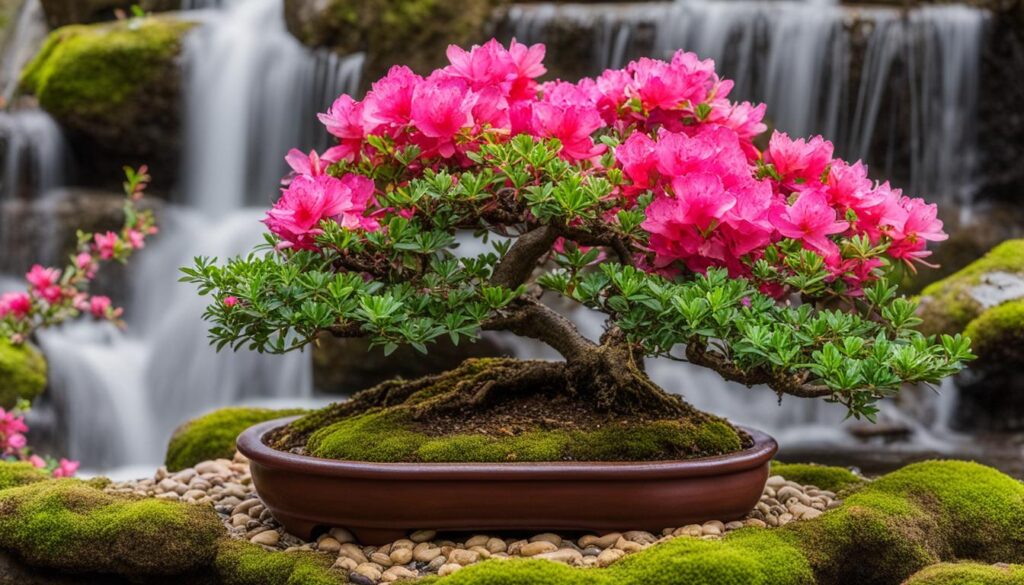
Creating the perfect environment for your Azalea Bonsai is crucial for its overall health and well-being. By providing the right conditions, you can ensure the longevity and vitality of your beautiful bonsai tree.
Whether you choose to keep your Azalea Bonsai indoors or outdoors, there are specific factors to consider to create an ideal environment:
Temperature:
Azalea Bonsai thrive in cool temperatures, ideally between 60°F and 70°F (15°C – 21°C). They are sensitive to extreme heat and cold, so it’s important to avoid exposing them to drastic temperature fluctuations.
Humidity:
Azalea Bonsai require high humidity levels to mimic their natural habitat. To increase humidity, you can place your bonsai tree on a humidity tray filled with water or use a humidifier.
Sunlight:
Azalea Bonsai prefers partial shade or filtered sunlight. Direct sunlight can scorch their delicate leaves, while insufficient light can hamper their growth and blooming. Place your plant in a location where it receives morning sun and afternoon shade.
Air Circulation:
Good air circulation is essential for preventing diseases and promoting healthy growth. Avoid placing your Azalea Bonsai in a stagnant or stuffy area. Instead, ensure proper ventilation by keeping a gentle breeze flowing around the tree.
Remember to monitor the environment regularly and make adjustments as needed to maintain the optimal conditions for your Azalea Bonsai. With the right environment, your bonsai tree will flourish and bring beauty to your home or garden.
Azalea Bonsai Pruning Techniques
Pruning is an important part of Azalea Bonsai care, as it helps maintain the desired shape and encourages new growth. With proper pruning techniques for azalea bonsai, you can enhance the aesthetic appeal and overall health of your Azalea Bonsai.
To effectively prune your plant, consider the following pruning techniques:
- Branch selection: Carefully choose which branches to keep and which to remove. Remove any weak or diseased branches to promote the health of your bonsai tree.
- Thinning: Thin out dense areas of foliage to allow for better airflow and light penetration. This will help prevent fungal diseases and promote balanced growth.
- Pinching: Pinch off the tips of new shoots to encourage branching and create a fuller and more compact silhouette.
By utilizing these pruning techniques, you can shape your Azalea Bonsai tree according to your desired vision and promote its overall health and vitality.
Dealing with Pests and Diseases in Azalea Bonsai
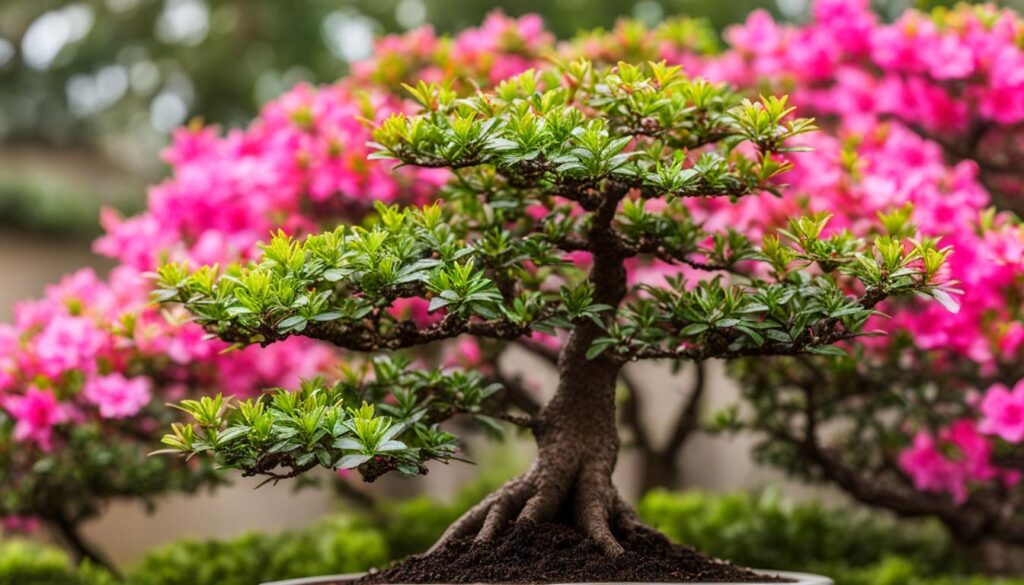
Like any plant, it can be prone to pests and diseases. In this section, we will identify common pests and diseases that affect Azalea Bonsai, such as spider mites, vine weevils, and root rot. We will provide preventive measures and treatment options to keep your plant healthy and free from infestations.
When it comes to pests, spider mites are a common problem for Azalea Bonsai. These tiny pests can cause significant damage by feeding on the leaves, leaving behind yellow or brown spots. To prevent spider mite infestations, regularly check the undersides of the leaves for any signs of webs or pests. Introducing natural predators like ladybugs or using insecticidal soap can help control spider mite populations.
Vine weevils are another pest that can target Azalea Bonsai. These insects primarily attack the roots of the bonsai, causing wilting and stunted growth. You can prevent vine weevil infestations by inspecting the soil regularly and removing any grubs or larvae. Consider using nematodes, which are natural predators of vine weevil larvae, to control their populations effectively.
Azalea Bonsai are also susceptible to various diseases, such as root rot. Root rot can occur due to overwatering or poor drainage, leading to the decay of the roots. To prevent root rot, ensure proper watering practices, allowing the soil to dry out slightly before watering again. Additionally, planting Azalea Bonsai in well-draining soil and pots with drainage holes can help prevent waterlogged conditions and reduce the risk of root rot.
By being vigilant and taking proactive measures, you can protect your Azalea Bonsai from pests and diseases. Regular inspection, proper watering, and appropriate use of natural control methods will contribute to the overall health and vitality of your masterpiece.
Displaying Your Azalea Bonsai: Tips for Exhibition
When it comes to showcasing your plant in an exhibition or show, attention to detail is paramount. The goal is to create a visually stunning presentation that highlights the unique beauty of your masterpiece. Here are some tips and techniques to help you display your bonsai at its best.
First and foremost, selecting the right display stand is crucial. The stand should complement the style and aesthetics of your Azalea Bonsai, enhancing its overall presentation. Consider the height, material, and design of the stand to create a harmonious and balanced display.
In arranging the branches and flowers, aim for a natural and artistic composition. Gently bend and position the branches to create an appealing silhouette, taking care not to over-manipulate them. Balance is key, so distribute the foliage and flowers evenly throughout the tree. This will create a sense of harmony and visual appeal.
Additionally, pay attention to the overall cleanliness and grooming of your Azalea Bonsai. Remove any dead leaves or debris and ensure that the soil is neat and well-maintained. A clean and well-groomed bonsai will leave a lasting impression on the viewers.
By applying these tips and techniques, you can create an exhibition display that truly showcases the beauty and artistry of your plant. Remember, the key is to pay attention to detail and create a visually pleasing composition. With careful planning and execution, your plant will shine in any exhibition or show.
This page contains some affiliate links. Please check out our affiliate disclaimer for more information

Karen Phillips, Bonsai expert and blogger. Read more about me here

